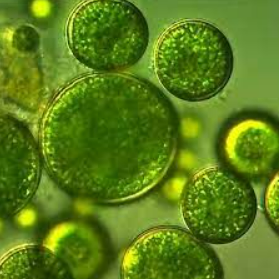Making your prototypes and products out of fossil fuel-based plastics is so yesterday. Take a step into a sustainable future by using a bio-based solution in your creative process.
Traditional polyurethane—those ubiquitous foams, plastics, and adhesives found everywhere in our world—are made from a chemical concoction that relies on non-renewable and polluting fossil fuels.
Checkerspot wanted to change the way we think about plasticity, casted materials. Instead of using petroleum for polyurethanes, the team wanted to replace the fossil fuel component of plastics with a renewable oil source.
They created the Pollinator Kit, a biomaterial that can change the way you create your art, prototypes, and models (and decrease your carbon footprint).
The Secret Ingredient: Algae
Instead of using fossil fuels that are sucked up from far underground, Checkerspot’s resin uses oil from a renewable source: algae. This tiny algae is fast-growing and eats a diet of sugar. When harvested, the algae can be up to 80% oil, making it an efficient fat-producer.
Checkerspot’s chemists used this algae-oil to create a new type of resin, containing at least 56% bio based oils. The USDA has certified their Pollinator formula as a Biobased product, which is a designation reserved for products that have been derived from renewable raw materials from agricultural, marine, and forestry sources.
| The result is a durable, high-detail, long-lasting polymer that allows more fossil fuels to stay in the ground. |  |
But does the resin hold up?
Fear not— the biobased, Pollinator Series formulations are durable, dyeable, and feel nice to the touch. Business partners have used Pollinator plastics in everything from surfboard fins, to new car shifting knobs, to resin-casted jewelry. Based on their needs, a maker can dial in the hardness, flexural strength, and impact resistance of the resin.
In fact, Pollinator formulas might even perform better than traditional petroleum-based materials. In tests, ski sidewalls made with Checkerspot’s algae-oil formula had 15% greater flexure than traditional polymers—this rose to a whopping 60% greater flexural strength at low temperatures.
Beyond performance, the material also looks great. Makers, inventors, and designers can use the Pollinator Kit for any casting projects they dream up. Finishes range from high gloss to rough sandcast textures—the satin finish is particularly pretty. To the touch, Checkerspot’s resin feels a bit warmer and softer compared to traditional plastics. The surface has a tiny amount of give, making the finished product have a liveliness that injected plastic can’t match.
The Pollinator Series has a natural, beeswax color that lends itself to some translucency when thin. Makers can add color to their resin, and both natural and synthetic pigments work with the kit. Natural pigments create a rich, rather subtle and soft-looking final product, while synthetic pigments can add some added perks like UV resistance.
“As a designer I often make choices about what materials a product will be made from. Usually there is a tradeoff between performance, cost, and sustainability,” says Mitch Heinrich, Founder and CEO of What For Design. He says Checkerspot’s technology and materials are “upending that paradigm and don't force me to make those tradeoffs.”
Want to take your casted creation to the next level? No problem—Pollinator plastics can be painted, glued or milled. Feel free to treat your cast like other traditional plastics and keep creating.

